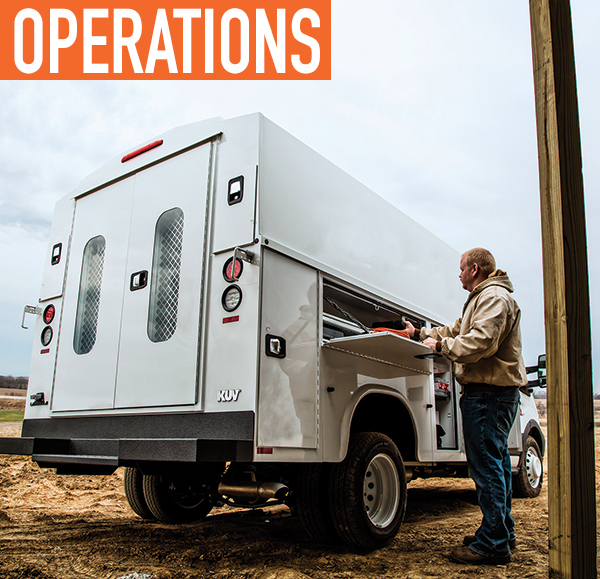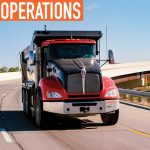Productivity is one of the many keys to your success and making the right decisions on the tools you use on a daily basis is vitally important. One of the most important tools that a tradesman or company chooses is their work vehicle. This choice is crucial to not only your bottom line, but also to your company’s image. But, how do you know if you are making the right decision? What are the key factors to consider as you make this huge investment? It fundamentally boils down to three key steps: selecting the right body, choosing the right vehicle or chassis, and picking the right accessories to make a custom-tailored work vehicle for your job and application.
SELECTING THE RIGHT BODY
When selecting the right body for your needs, it is critical that you make a very accurate and all-encompassing inventory of what your job requirements are. Can you work with an open body or need something enclosed? How much cargo space and capacity do you require? What about enclosures and security? What types of tools and equipment will you be hauling—both in and out of your truck body?
These are all questions that you need to answer as you sort through the almost endless selection of body options that are available on the market today. Understanding your needs will get you off to a good start in determining the right configuration and size of body needed to allow you to operate efficiently.
Finally, what material body should you choose? Today, there are three main types of materials to consider: steel, aluminum, and fiberglass composite. When selecting a body material, keep in mind the environments you will be working in, as well as the level of abuse that your vehicle body will be taking as you go about your jobs and locations. Again, the numbers of body configurations and types are almost endless and making the right selection is crucial.

Featured Image: The KUV Vocational Body on this Ford Transit offers organization and security.
Above: Sporting a PCON-12DB open body makes this Ford a well-organized tool.
CHASSIS OF CHOICE
Once you choose the right body for your needs, you’ll need a chassis underneath it to make it a work truck. Again, the possibilities are vast and establishing the right balance between use and capability is essential to optimizing your operation. For example, gas or diesel, 2WD or 4WD, van or truck are just a few of the choices you will need to make as part of this process.
One of the most important decisions will stem from an understanding of how much weight or capacity the chassis will need to carry or move down the road. Depending on this, you can select from a variety of chassis based on GVWR and vehicle classes. However, going “bigger” may not always be the best solution. Larger vehicles may require certified drivers and could limit how easily you may be able to access worksites and urban areas.
Finally, you need to consider that this vehicle will possibly become your or you operator’s “mobile office.” Making sure that you are comfortable and secure will only improve your productivity and will be positively portrayed to your customers.
ACCESSORIZE, ACCESSORIZE
Like they say, it’s the details that count. And, in the work truck environment, selecting the right accessories or ancillary equipment is what sets apart the competition. From major equipment, such as lifting apparatus, generators, air compressors, and welders to minor items, such as stowage hooks, shelf dividers, and hat holders—how you choose your accessories is a very important part of making your work truck operational and efficient. Again, the options and selections are endless; however, fully understanding your work needs and operating environments is crucial. Understanding the limitations of your selected chassis and body combination is important, as well.
Finally, safety and security should be the most important attributes to consider. Choosing the appropriate accessories to ensure safety and security of your equipment—and employees—should be the first aspect to consider when building your next work vehicle.

This GM is ready for work with a vocational Service Body.
MAKE THE RIGHT CHOICES
Over the years, a tight network of equipment manufacturers, distributors, and OEM dealers has been formed to help you through the work vehicle selection and upfitting process. Although the task may seem daunting, leveraging this network will ensure that you get the right truck for the job and it is optimized to improve your operational performance and efficiency. Another option would be to utilize one of several fleet management companies. These companies all have personnel that specialize in working with customers to design upfits and select the appropriate chassis for the specific job requirements.
So, making the right decisions when selecting your next work truck or vehicle could make the difference in your overall productivity and efficiency, both from an operational and financial perspective. There are resources to turn to that can help you through the process. Making sure that you make an educated decision is vital to your overall safety and success.
FOR MORE INFORMATION:
Mandar Dighe is vice president of marketing for the The Knapheide Manufacturing Company—North America’s most popular manufacturer of truck bodies and truck beds—in Quincy, Illinois..
_______________________________________________________________________
MODERN WORKTRUCK SOLUTIONS: MARCH 2016 ISSUE
Did you enjoy this article?
Subscribe to the FREE Digital Edition of Modern WorkTruck Solutions magazine.
![]()




